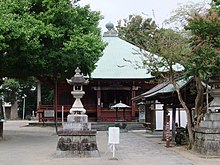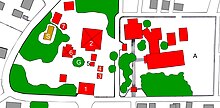Shōfuku-ji (Odawara)
The Shōfuku-ji ( Japanese 勝 福寺 ), with the mountain name Iizumi-zan ( 飯 泉山 ), hence also simply Iizumi Kannon ( 飯 泉 観 音 ), is a temple of the Shingon direction of Buddhism in Odawara ( Kanagawa Prefecture ), Japan. In the traditional count it is the 5th of the 33 temples in the Kantō region .
history
During the Nara period , priest Jianzhen (688-763) left a Kannon given by Emperor Kōken to the priest Dōkyō († 772), who set it up in Yuge-ji ( 弓 削 寺 ) on the Chiyodai hill. From there it finally got here.
The attachment
You enter the temple complex through the mighty, copper-covered temple gate, which is designed here as a Niō gate ( 仁王 門 Niō-mon ; 1 in the plan), i.e. as a gate with the two temple guards ( Niō ) to the right and left of the passage. Ahead you can see the copper-covered main hall ( 本 堂 Hondō , 2). The current building dates from 1706 and is registered as a cultural asset of the prefecture. The hall shows the style of the early Edo period, modified in a way that is typical of esoteric Buddhism ( 密 教 Mikkyō ). The front area ( 外 陣 gejin ) is 2 ken , here 3.63 m deep and the inner area ( 内 陣 naijin ) 5.45 m. If you climb the steps to the hall and enter the building, you can see carved flying angels ( 飛天 Hiten ) in front of the inner area .
On the way to the main hall you pass a building designed as a treasure pagoda to the right to receive the sutras ( 納 経 塔 Nōkyōtō ; 3) and the bell tower ( 鐘楼 Shōrō ; 4). The inscription on the bell points to the year 1629 and indicates that it was cast in Odawara, during the time of the Later Hōjō , when the city was a center of bell foundry. In front of the bell tower there is a bronze water vessel ( 青銅 水; Seidō mizubachi ; 5), which has the shape of a dragon boat ( 龍頭 船 Ryūtōsen ). It was made in the Kanda district of Edo, what is now Tokyo. On the left is a small hall, which is probably dedicated to the Dainichi Buddha (6). The small octagonal building at the back left houses a "horse head Kannon " ( 馬頭 観 音 Batō Kannon ; 7).
On the left in front of the main hall is a large female ginkgo tree (G), a natural monument of the prefecture. It is intended to fulfill requests from women for larger breasts.
There is a Hachiman Shrine ( 八 幡 achim Hachiman-jinja ; S) on the temple grounds , which is surrounded by large, densely packed trees. This dense group of trees called Jusō ( 樹叢 ) is registered as a natural monument of the prefecture. The shrine is an example of the merging of Buddhism and Shintoism that has been sought for a while.
To the east is the extensive abbot and monk area (A).
Treasures of the temple
In the shrine ( 厨子 Zushi ) behind the Kannon in the foreground there is an eleven-faced Kannon ( 十 一面 観 音 Jūichimen Kannon ), which is not publicly shown and is registered as a cultural asset of the prefecture. It is made from a piece of sandalwood, probably by a local carver, and is dated to the early Heian period .
literature
- Kanagawa-ken kotogakko Kyoka kenkyukai shakaika bukai rekishi bunkakai (Ed.): Iizumi Kannon . In: Kanagawa-ken no rekishi sampo (ge). Yamakawa Shuppan, 2005. ISBN 978-4-634-24814-4 . Pp. 216, 217.
Web links
Coordinates: 35 ° 16 ′ 48.1 ″ N , 139 ° 9 ′ 51.6 ″ E


